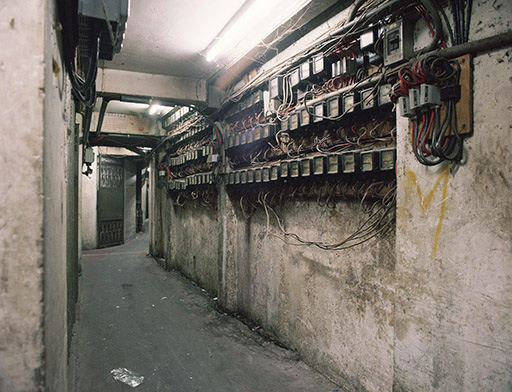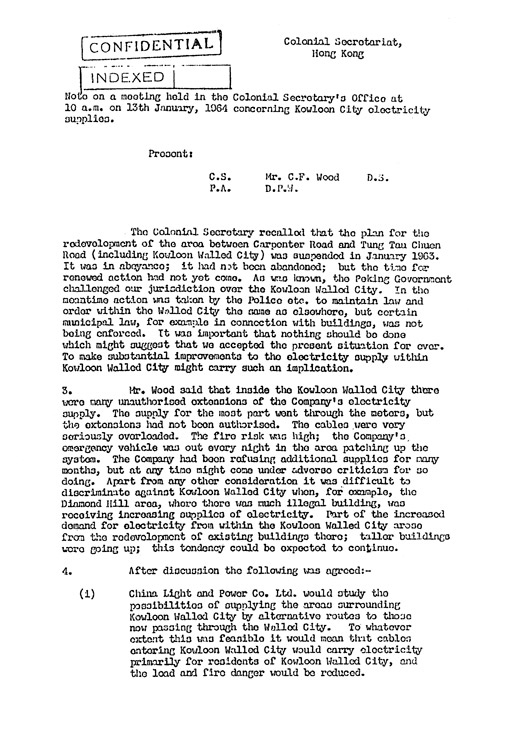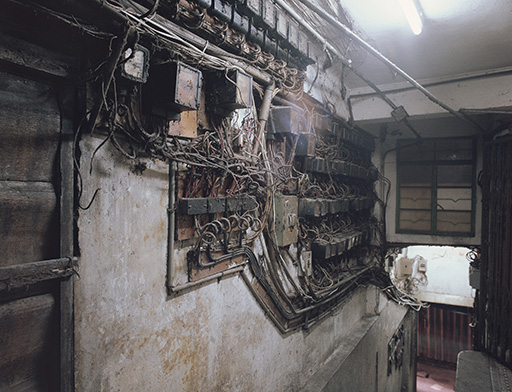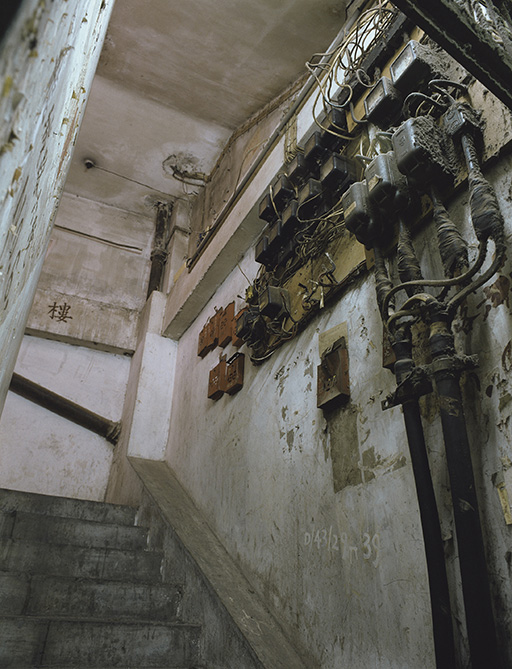POWER FOR ALL

Just as it was feared a universal supply of safe drinking water to the City’s residents would confer some sort of legitimacy on the Walled City as a whole, so it was with the installation of a safe and reliable electrical supply. The Government decided to supply water through a strictly limited number of standpipes, which while undoubtedly inconvenient was relatively safe. The same solution, however, would not work with electricity.
The danger of not providing electricity to those who needed or wanted it had been brought home to the Hong Kong Government following a huge fire at the Shek Kip Mei ‘squatter’ settlement (in reality refugees from China) on Christmas Day 1953, which left over 50,000 people homeless. Up until that time, electricity had not been supplied to such settlements, forcing their inhabitants to rely on Kerosene lamps and stoves for lighting and cooking. This could not be allowed to continue and over the next few years China Light and Power gradually installed a permanent supply to all Hong Kong residents, regardless of status and location – including the Walled City.
Even then, the supply to the Walled City remained far less than demand required. A Government memo of January 1964 noted that: “inside the Kowloon Walled City there were many unauthorised extensions of the Company’s electricity supply. The cables were very seriously overloaded. The fire risk was high; the Company’s emergency vehicle was out every night in the area patching up the system.”

Somewhat grudgingly China Light and Power was allowed greater access, but an increased supply only engendered greater demand, leaving the Company forever struggling to keep up. In fairness, this situation applied to Hong Kong as a whole during a decade of dramatic growth, but the situation was especially acute in the Walled City and it was only in the mid 1970s that the Company decided to initiate a complete overhaul of the City’s supply.
Mok Chung Yuk was one of the company’s engineers responsible and here below are his recollections of the situation when he started working in the City in 1977. Unsurprisingly, these are not always entirely accurate, particularly with regard overall policy, but they do provide an excellent description of the practical problems of installing and maintaining a relatively safe and reliable electrical service throughout the City at that time.
“Following a big fire in the City in 1977, everyone realised things had to change. We began drafting a plan to supply electricity throughout the City and the Government established guidelines as to which buildings were acceptable. The years 1977 to ’85 were years of drastic transformation. The local District Office began to collaborate with the Kai Fong, and Government involvement in the City also increased. Later, just before the Sino-British Agreement was signed, China told the British that they could exercise full authority over the City and things became much easier.
I was one of those doing the groundwork for the new electricity supply – I carried out the very first surveys. In fact, I remember well the first time I went in – edging in a short way then turning back! It seemed very frightening at the time. We all dressed down at first, and we were careful not to enter looking like an official team. Only when we were familiar with the streets and alleys did we bring out our maps and plans. For the first few days, before we got talking to any of the locals, we just got used to the place.
We had two big worries in those early months. First, we had no idea what we would find and, second, when we found out how bad it was, we had no idea how to cope with the chaos. We quickly saw the difficulties: the narrow alleys, the filth, the rubbish, the character of the people living and working there. A few of my colleagues were robbed, possibly by drug addicts; they would even take $30. We were never really hassled by thugs though, since so many Government departments were involved in the project, including the police. And so was the Kai Fong, of course. Also, the majority of residents saw the need for electricity, so nothing unruly took place.
There were many specific technical problems. The City was just a maze of pipes and wires all over the place. We were at a loss where to begin! Eventually we decided that we’d just have to make a start from the outside and work in – take the cable and enter inch by inch. The alleys were incredibly narrow, and in places we needed to dig up the ground to lay the cable. But when we were digging we’d often strike rock or stone and have to stop. After several meetings in the City, we agreed to raise the level of the pavement instead!
We had to invent many new ways of installing cables. We’d try one way first and if that worked we’d use it again. Occasionally there’d be problems, of course. People didn’t like us fixing cables to their walls, for example, and it took some persuasion before such matters were resolved. Sometimes the wiring had to go through someone else’s premises and, of course, some saw this as an invasion. In these cases, we just had to let the applicant negotiate with the owner. Actually, in a few instances, we just supplied electricity to the power points on a lower floor and let the owner connect it to the floor above. You know what the buildings are like in the Walled City – they’re built one on top of the other, leaning here and there. In some cases, there was no way to make the necessary connections all the way up to the top floors. Of course, we’d check everything was done properly before switching on.
Hong Kong’s economy was growing fast at that time, and as everyone became better off they bought more and more electrical goods. The population was increasing fast as well. The Walled City itself was booming, with a huge amount of new construction going on. All these things contributed to an increased demand for electricity.
With more and more people in the City wanting electricity, we had to find space for the transformer we needed to cope with two high-density cables we were planning to bring in. We finally managed to persuade the church in the City to rent us around 250 square feet on condition we renovated their school. We also kept badgering the Government to release space cleared because of fires so we could build a couple more sub-stations. We discussed this with the authorities for several years, in fact, until they eventually gave us permission in 1984. It took us three years to set up the stations, by which time they had announced they were going to tear the place down!
By this time almost every flat had electricity. But that didn’t take care of all the factories. When we started out we had no idea there’d be so many. We had made provision in our plans for some excess supply, but we’d underestimated the demand – we’d often have to make spur-of-the-moment adjustments and modifications to meet requirements as we found them.
There are, of course, instances of electricity theft. Certainly, the total supply of electricity is not fully paid up or accounted for. But it’s no longer easy to steal from the Company on a large scale. When they see us, factory owners using stolen electricity are careful to hide any evidence that might give cause for suspicion. Many also realise that stolen electricity might not be that much cheaper. At least when they get their supply direct from the Company, they are never threatened or subject to extortion.
In the past, those who stole were not dealt with very effectively. This is partly because our employees didn’t dare go too far into the City! But even if action was taken, we’d usually have to bring the police in – and they did not have much authority in the place themselves. Some people claimed they had their own private power sources, which just wasn’t true! They stole from China Electric but were only rarely brought to account. If they were discovered, they’d just be disconnected.
Bringing electricity to the City was not just a unique project for Hong Kong, but pretty much anywhere I’d say. Because of the background of the place, and the conditions and environment there, we were forced to make many innovations and to problem-solve. I myself feel happy, however, that people are finally moving out, although I feel that the Government is spending far too much on compensation. When the clearance was announced, I’m sure many people moved in quickly enough to spend a couple of nights in the City, in the hope that they could benefit too.”

